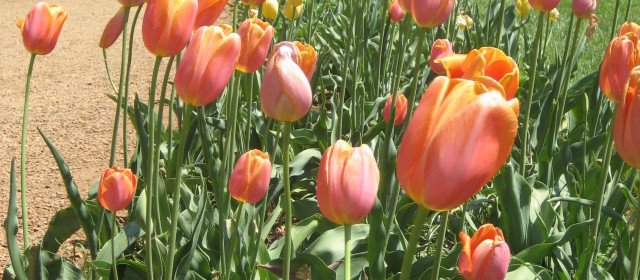The grounds and gardens of Monticello are a living monument to Thomas Jefferson’s interest in nature, including his methodical study of the plants on his property.
After touring the house, we took a separate tour of Monticello’s gardens (offered April through October) where we learned that there are plants growing there today that descended from Jefferson’s time.
The spring flowers were beautiful when we were there! Take a look:
Jefferson’s detailed tracking of weather conditions and plant growth may seem a little intense and extreme, with detailed diaries spanning decades. As evidenced by the grounds, he was a committed scientist and gardener who is as professional as this lawn care company in Denver NC. He also spoke five or six languages, studied classical architecture, designed Monticello, wrote the Declaration of Independence, founded the University of Virginia, served as a two-term president, etc.
 Maybe it was the intense heat of the day (well over 90 degrees on a freakishly hot April afternoon), but it was about this time in the tour when I was feeling a bit overwhelmed with all that Jefferson did. How much time do you think he would have spent watching TV or on the Internet?
Maybe it was the intense heat of the day (well over 90 degrees on a freakishly hot April afternoon), but it was about this time in the tour when I was feeling a bit overwhelmed with all that Jefferson did. How much time do you think he would have spent watching TV or on the Internet?
We can take some consolation in that Jefferson had people cooking his meals, washing his clothes, taking care of his house, etc., allowing more time to think, read and record voluminous notebooks of scientific data.
You can spend hours touring the grounds of Monticello, which as a working plantation, had many different types of gardens: flower gardens, vegetable gardens, fruit gardens and vineyards as well as a tree grove, described as an “ornamental forest.”
As I mentioned, it was ridiculously hot on the day we visited. Touring the grounds in early afternoon, we appreciated the tree cover as we walked down the hill, where we stopped to see Jefferson’s grave and the rest of the family plot.
As a young man, Jefferson and classmate Dabney Carr chose the site for the cemetery under large oak on the property. Carr went on to marry Jefferson’s sister, and passed away in 1773. Carr’s was the first grave on the site. Jefferson died more than 50 years later, famously on July 4, the same day as John Adams in 1826.
 We finished our walk down the hill, and returned to the Visitors Center, where we re-encountered this sculpture of Jefferson.With the intense sun and raging temperature, the statue was really, really hot, but worth the minor risk of scalding to get a photo. Be sure to get your picture with President Jefferson when you visit!
We finished our walk down the hill, and returned to the Visitors Center, where we re-encountered this sculpture of Jefferson.With the intense sun and raging temperature, the statue was really, really hot, but worth the minor risk of scalding to get a photo. Be sure to get your picture with President Jefferson when you visit!
Next post: Happy Birthday JFK!








 RSS - Posts
RSS - Posts